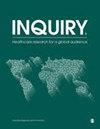特定文化电子食物频率问卷的有效性和可重复性:特立尼达和多巴哥饮食评估研究
IF 1.7
4区 医学
Q3 HEALTH CARE SCIENCES & SERVICES
Inquiry-The Journal of Health Care Organization Provision and Financing
Pub Date : 2024-09-14
DOI:10.1177/00469580241273247
引用次数: 0
摘要
营养流行病学家使用特定文化的食物频率问卷(FFQ)来评估基于国家、地区或种族群体的膳食摄入量。本研究旨在验证针对特定文化的半定量电子食物频率问卷(e-FFQ),以估算特立尼达和多巴哥成年人群的食物摄入量。该研究对 18 岁及以上的成年人进行了两次半定量电子食物频率问卷调查,共 139 项,内容包括当地菜肴和街头食品,并将其与作为参考方法的四份使用数码照片的 1 天食物记录(FRs)进行了比较。采用配对 t 检验、双变量相关性和交叉分类确定了电子食物调查表食物组别摄入量估计值的有效性和再现性。在首次和再次使用电子食物调查表时,所报告的食物类别摄入量之间的再现性相关性从甜饮料的中度相关性(r = .44,P ≤ .0001)到酒精的高度相关性(r = .91,P ≤ .0001)不等。交叉分类的一致性从 70%(街头食品)到 92%(酒精)不等。经能量调整后,e-FFQ 和 FR 之间的去衰减效度相关性从水的 ( r = 0.08) 到动物源性食物的 ( r = 0.81) 不等,平均效度相关性为 0.36。平均有 68% 的电子食物频率估计值被正确归类到与食物来源标准完全一致的 ±1 五分位数范围内。e-FFQ 与食物来源标准的一致性从街头食品的 55% 到水的 95% 不等,均有显著性意义(P ≤ .0001)。这项研究表明,特立尼达和多巴哥成年人的食物类别摄入量估计值中,针对特定文化的电子食物调查表是一种有效的评估和排序工具。本文章由计算机程序翻译,如有差异,请以英文原文为准。
Validity and Reproducibility of a Culture-Specific Electronic Food Frequency Questionnaire: A Trinidad and Tobago Diet Assessment Study
Nutritional epidemiologists use culture-specific food frequency questionnaires (FFQs) to assess the dietary intake of groups based on country, region or ethnic groups. This study aimed to validate a culture-specific semi-quantitative electronic Food Frequency Questionnaire (e-FFQ) to estimate food group intake in the adult population of Trinidad and Tobago. A 139-item semi-quantitative e-FFQ containing local dishes and street food was administered twice to adults 18 years and older and compared against four 1-day food records (FRs) using digital photographs, which served as the reference method. The validity and reproducibility of the e-FFQ food group intake estimates were determined using paired t-tests, bivariate correlations, and cross-classifications. Reproducibility correlations between the reported food group intakes in the first and repeat administration of the e-FFQ ranged from moderate ( r = .44, P ≤ .0001) for sweetened beverages to high ( r = .91 P ≤ .0001) for alcohol. The cross-classification agreements ranged from 70% (street food) to 92% (alcohol). Energy-adjusted deattenuated validity correlations between the e-FFQ and FR ranged from ( r = .08) for water to ( r = .81) for food from animal sources, with a mean validity correlation of .36. An average of 68% of the e-FFQ estimates was correctly classified within the ±1 quintile of the exact agreement with the FRs. Agreements between the e-FFQ and FRs ranged from 55% for street foods to 95% for water, all significant at P ≤ .0001. This study shows that the culture-specific e-FFQ is a valid tool for assessing and ranking food category intake estimates of the adult population living in Trinidad and Tobago.
求助全文
通过发布文献求助,成功后即可免费获取论文全文。
去求助
来源期刊
CiteScore
2.50
自引率
0.00%
发文量
192
审稿时长
>12 weeks
期刊介绍:
INQUIRY is a peer-reviewed open access journal whose msision is to to improve health by sharing research spanning health care, including public health, health services, and health policy.

 求助内容:
求助内容: 应助结果提醒方式:
应助结果提醒方式:


